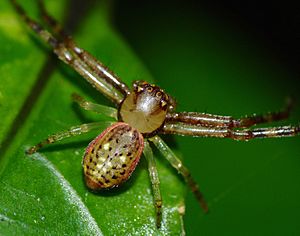Diaea ambara facts for kids
Quick facts for kids Diaea ambara |
|
|---|---|
 |
|
| Scientific classification | |
| Genus: |
Diaea
|
| Species: |
ambara
|
| Synonyms | |
|
Philodromus ambarus |
|
The Diaea ambara is a type of crab spider that lives only in New Zealand. This means it is endemic to that country and can't be found naturally anywhere else in the world.
Contents
What is the Diaea ambara?
The Diaea ambara is a small spider known for its unique hunting style. It doesn't spin webs to catch food. Instead, it waits hidden and ambushes its prey.
How was the Diaea ambara named?
Spiders, like all living things, are given scientific names to help scientists study them. The Diaea ambara was first described in 1885 by a scientist named Arthur Urquhart. He first called it Philodromus ambarus. Later, scientists decided it fit better into a different group, or genus, called Diaea. So, its name was changed to Diaea ambara. This process of naming and classifying living things is called taxonomy.
What does the Diaea ambara look like?
Female Diaea ambara spiders are usually about 6 millimeters long. That's roughly the size of a pencil eraser! Their main body part, called the cephalothorax, is a golden-brown color. Their abdomen, which is the back part of their body, is tan and might have some light markings.
However, these spiders can change their color quite a bit. This color change helps them blend in with their surroundings. It's like they have a natural camouflage, making it harder for predators to spot them. It also helps them hide from the insects they want to catch for food.
How does the Diaea ambara behave?
Diaea ambara spiders are known as ambush predators. This means they don't chase their food. Instead, they hide on the leaves of bushes and trees. They wait patiently for an unsuspecting insect to come close enough. Then, they quickly pounce and catch their meal.
When it's time for mating, the male spider goes looking for a female. He approaches her carefully from the side. He uses his front legs to gently touch her front legs, and then her body. The female spider usually pulls her legs in and crouches down.
After this, the male spider uses silk to gently tie the female down. He then crawls underneath her to mate. Once mating is finished, the male leaves. The female can easily free herself from the silk.
See also
 In Spanish: Diaea ambara para niños
In Spanish: Diaea ambara para niños

